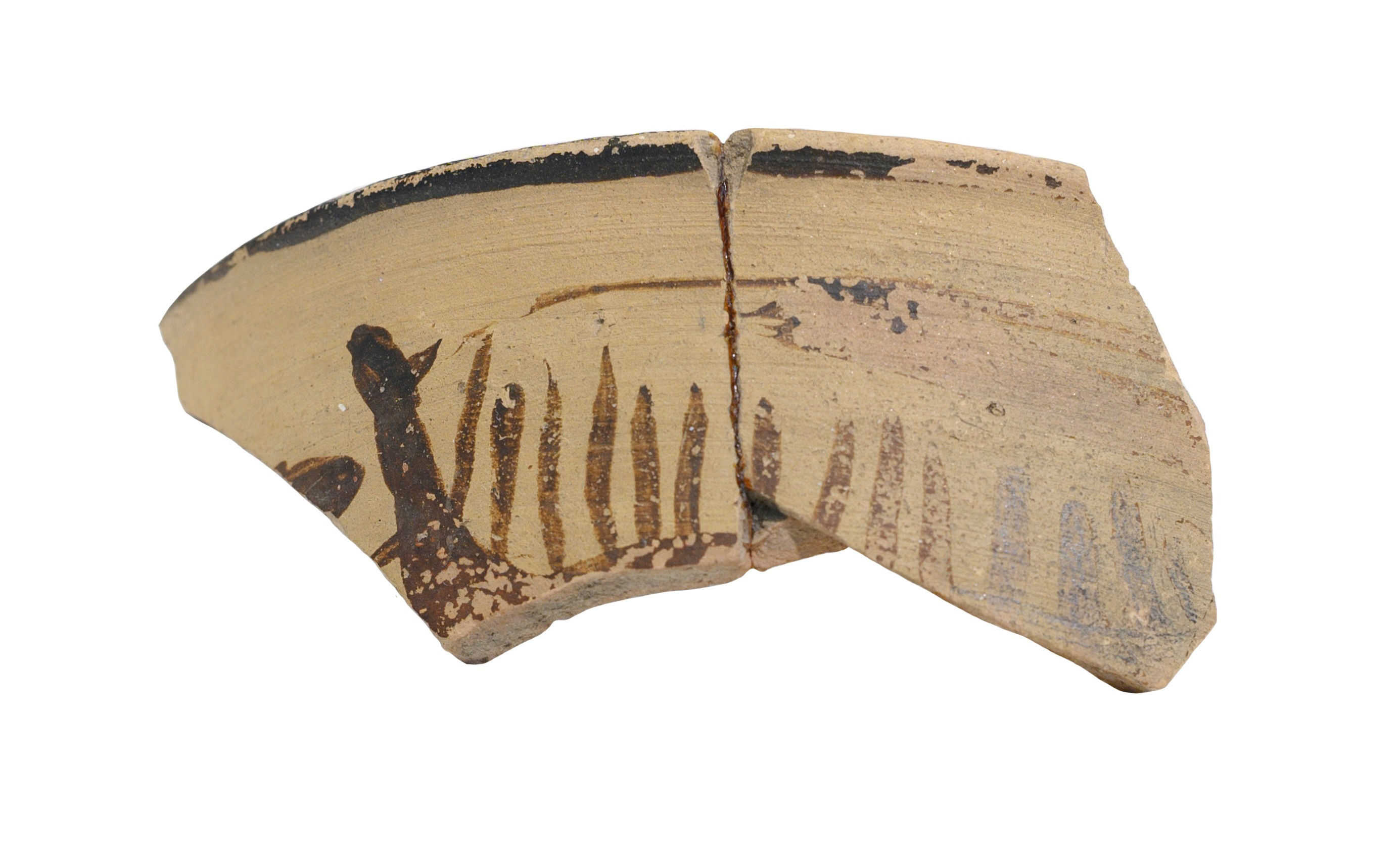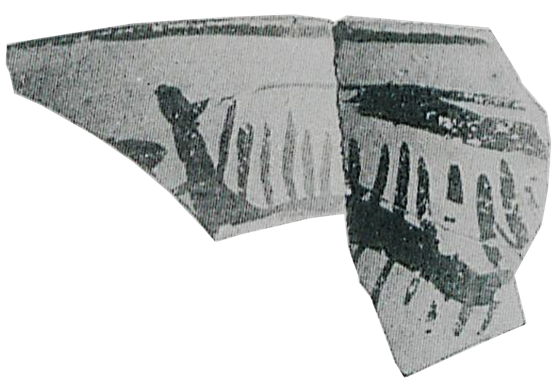Fragmentary flat hull with a high post on the left rising with a slight outward inclination and ending in a bifurcation. The outer edge of the post has a downward pointing oblique line. Along the entire length of the hull there are vertical parallel lines which extend above (14 extant) and below (six extant). Entering from the right edge of the sherd is a thin horizontal line (yard?) as well as a thicker shorter parallel line attached to it underneath (furled sail ?).
Sailing ship
A102
LH IIIC middle developed
Phylakopi IV
L: 10.5 cm; H: 6.1; thickness 1.3 cm
Body and rim fragments of mug (3 sherd joins). Reddish clay with cream slip, dark-brown lip-band and ship. Interior monochrome
Athens National Archaeological Museum 12099
Morricone 1972-1973: 361; Mountjoy 1999: fig. 376.191; 2007: 349-350, fig. 8.25, no. 449; Sakellarakis 1992: 117 nr 257; Thomatos 2006: 122-123, fig. 1.424; Vermeule and Karageorghis 1982: XII.33; Wachsmann 1981: 200; Wedde 2000: 327, no. 664
Mountjoy remarks that the very straight sides and the small diameter of the vase suggest that the shape is a mug rather than a deep bowl. It finds a parallel from Miletus (Schiering 1960, pl. 72.2). The sherd has broken since the original illustration.
Wedde interprets the extant post as the stern half of the ship because of the first from the left slightly oblique vertical line which he reads as a steering oar. He argues that the oarsmen have been furthermore reduced to lines only, of which 13 are extant, with a reconstructed length of about 25 rowers. The vessel cannot be assigned with certainty to either type V (Skyros cluster) or VI (Tragana cluster). If the interpretation of a furled sail is correct, the ship has a loose-footed sail.
Morricone, L. 1972-1973. “Coo – scavi e scoperte nel ‘Serraglio’ e in località minori (1935-1943),” Annuario 50-51: 139-396.
Mountjoy, P.A. 1999. Regional Mycenaean Decorated Pottery. Rahden: Deutsches Archäologisches Institut.
―――. 2007. “A Definition of LH IIIC Middle,” in S. Deger-Jalkotzy and M. Zavadil (eds.) LH IIIC Chronology and Synchronisms II: LH IIIC Middle. Proceedings of the International Workshop held at the Austrian Academy of Sciences at Vienna, October 29th and 30th, 2004. Vienna: Austrian Academy of Sciences, pp. 221-242.
Sakellarakis, J.A. 1992. Mycenaean Pictorial Style in the National Archaeological Museum of Athens. Athens: Kapon Editions.
Thomatos, M. 2006. The Final revival of the Aegean Bronze Age: a case study of the Argolid, Corinthia, Attica, Euboea, the Cyclades and the Dodecanese during LH IIIC Middle. Oxford: Archaeopress.
Vermeule, E. and V. Karageorghis. 1982. Mycenaean Pictorial Vase Painting. Cambridge, Mass.: Harvard University Press.
Wachsmann, S. 1981. “The Ships of the Sea People,” IJNA 10: 187-220.
Wedde, M. 2000. Towards a Hermeneutics of Aegean Bronze Age Ship Imagery. Peleus Studien zur Archäologie und Geschichte Griechenlands und Zyperns, vol. 6. Bibliopolis: Mannheim and Möhnsee.






